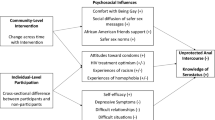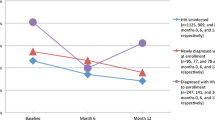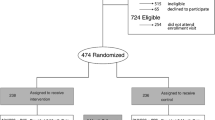Abstract
HIV treatment optimism and the ways in which news of HIV biomedical advances in HIV is presented to the most at-risk communities interact in ways that affect risk behavior and the incidence of HIV. The goal of the current study was to understand the relationships among HIV treatment optimism, knowledge of HIV biomedical advances, and current and expected increased risk behavior as a result of reading hypothetical news stories of further advances. Most of an online-recruited sample of MSM were quite knowledgeable about current biomedical advances. After reading three hypothetical news stories, 15–24% of those not living with HIV and 26–52% of those living with HIV reported their condom use would decrease if the story they read were true. Results suggest the importance of more cautious reporting on HIV biomedical advances, and for targeting individuals with greater treatment optimism and those living with HIV via organizations where they are most likely to receive their information about HIV.



Similar content being viewed by others
References
Deeks SG, Lewin SR, Havlir DV. The end of AIDS: HIV infection as a chronic disease. Lancet. 2013;382(9903):1525–33.
Fox KK, del Rio C, Holmes KK, et al. Gonorrhea in the HIV era: a reversal in trends among men who have sex with men. Am J Public Health. 2001;91(6):959–64.
Centers for Disease Control and Prevention. Primary and secondary syphilis among men who have sex with men—New York City, 2001. MMWR Morb Mortal Wkly Rep. 2002;51(38):853–6.
Helms DJ, Weinstock HS, Asbel LE, et al. Increases in syphilis among men who have sex with men attending STD clinics, 2000–2005. In: Program and abstracts of the 17th Biennial Meeting of the ISSTDR; 2007 Jul 29–Aug 1; Seattle, WA. Abstract No. P-608.
Centers for Disease Control and Prevention. Sexually transmitted disease surveillance 2007 supplement: Gonococcal Isolate Surveillance Project (GISP) annual report 2007. Atlanta: U.S. Department of Health and Human Services; 2007.
Purcell DW, Johnson CH, Lansky A, et al. Estimating the population size of men who have sex with men in the United States to obtain HIV and syphilis rates. Open AIDS J. 2012;6(Suppl1: M6):98–107.
Herbst JH, Jacobs ED, Finlayson TJ, et al. Estimating HIV prevalence and risk behaviors of transgender persons in the United States: a systematic review. AIDS Behav. 2008;12:1–17.
Padian NS, McCoy SI, Karim SSA, et al. HIV prevention transformed: the new prevention research agenda. Lancet. 2011;378:269–79.
DiClemente RD, Seth P, Mehrotra P. The evolving global HIV pandemic: Epidemiology, prevention, and future priorities. In: Zimmerman RS, DiClemente RD, Andrus J, editors. Introduction to global health promotion. New York: Wiley; 2016. p. 239–70.
CDC. HIV and AIDS—United States, 1981-2000. MMWR Wkly. 2001;50(21):430–4.
CDC. High-impact HIV prevention: CDC’s approach to reducing HIV infections in the United States. 2011. https://www.cdc.gov/hiv/pdf/policies_NHPC_Booklet.pdf.
Cohen MS, Chen YQ, McCauley M, Gamble T, Hosseinipour M, Kumarasami M, et al. Prevention of HIV-1 infection with early antiretroviral therapy. N Engl J Med. 2011;365:493–505.
Montaner JSG, Lima VD, Barrios R, Yip B, Wood E, Kerr T, et al. Association of highly active antiretroviral therapy coverage, population viral load, and yearly new HIV diagnoses in British Columbia, Canada: a population-based study. Lancet. 2010;376(9740):532–9.
Peterson JL, Miner MH, Brennan DJ, Rosser BRS. HIV treatment optimism and sexual risk behaviors among HIV positive African American men who have sex with men. AIDS Educ Prev. 2012;24(2):91–101.
Valdiserri RO. Mapping the roots of HIV/AIDS complacency: implications for program and policy development. AIDS Educ Prev. 2004;16(5):426–39.
Stolte IG, Dukers N, Geskus RB, Coutinho RA, Wit J. Homosexual men change to risky sex when perceiving less threat of HIV/AIDS since availability of highly active antiretroviral therapy: a longitudinal study. AIDS. 2004;18(2):303–9.
Sullivan PS, Drake AJ, Sanchez TH. Prevalence of treatment optimism-related risk behavior and associated factors among men who have sex with men in 11 states, 2000–2001. AIDS Behav. 2007;11(1):123–9.
Brennan DJ, Welles SL, Miner MH, Ross MW, Rosser BRS. HIV treatment optimism and unsafe anal intercourse among HIV-positive men who have sex with men: findings from the Positive Connections Study. AIDS Educ Prev. 2010;22(2):26–137.
Kalichman SC, Eaton L, Cherry C. Sexually transmitted infections and infectiousness beliefs among people living with HIV/AIDS: implications for HIV treatment as prevention. HIV Med. 2010;11(8):502–9.
Katz MH, Schwarcz SK, Kellogg TA, Klausner JD, Dilley JW, Gibson S, et al. Impact of highly active antiretroviral treatment on HIV seroincidence among men who have sex with men: San Francisco. Am J Public Health. 2002;92(3):388–94.
Dearing JW, Kim DK. The agenda-setting process and HIV/AIDS. In: Edgar T, Noar SM, Freimuth VS, editors. Communication perspectives on HIV/AIDS for the 21st century. New York: Taylor & Francis; 2008. p. 277–96.
Brodie ME, Hemel LA, Brady J, et al. AIDS at 21: media coverage of the HIV epidemic 1981-2002. Columbia Journal Rev. 2004;42:A1.
Stevens RC, Hull SJ. The colour of AIDS: an analysis of newspaper coverage of HIV/AIDS in the United States from 1992-2007. Crit Arts. 2013;27(3):352–60.
Zillmann D, Brosius HB. Exemplification in communication: the influence of case reports on the perception of issues. New Jersey: Erlbaum; 2000.
Zillman D. Exemplification theory of media influence. In: Bryant J, Zillman D, editors. Media effects: advances in theory and research. New Jersey: Erlbaum; 2002. p. 19–42.
Zillman D. Exemplification effects in the promotion of safety and health. J Commun. 2006;56(s1):S221–37.
Boyson A, Zimmerman RS, Shoemaker S. Exemplification of HAART and HIV/AIDS: a news experiment. Health Commun. 2015;30(9):901–10.
Brennan DJ, Welles SL, Miner MH, Ross MW, Mayer KH, Rosser BRS. Development of a treatment optimism scale for HIV-positive gay and bisexual men. AIDS Care. 2009;21(9):1090–7.
Acknowledgements
This study was funded with internal funds from the University of Missouri-St. Louis College of Nursing.
Author information
Authors and Affiliations
Corresponding author
Ethics declarations
Conflict of interest
Dr. Zimmerman received a small grant from the University of Missouri—St. Louis to conduct part of this study. The second author has no conflict of interest.
Ethical Approval
All procedures performed in studies involving human participants were in accordance with the ethical standards of the institutional and/or national research committee and with the 1964 Helsinki declaration and its later amendments or comparable ethical standards. Also the UMSL IRB approved the study. This article does not contain any studies with animals performed by any of the authors.
Informed Consent
Informed consent was obtained from all individual participants included in the study.
Rights and permissions
About this article
Cite this article
Zimmerman, R.S., Kirschbaum, A.L. News of Biomedical Advances in HIV: Relationship to Treatment Optimism and Expected Risk Behavior in US MSM. AIDS Behav 22, 367–378 (2018). https://doi.org/10.1007/s10461-017-1744-3
Published:
Issue Date:
DOI: https://doi.org/10.1007/s10461-017-1744-3




